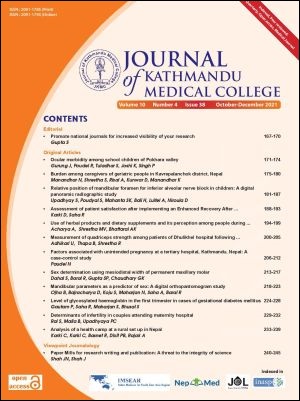Ocular morbidity among school children of Pokhara valley
DOI:
https://doi.org/10.3126/jkmc.v10i4.43856Keywords:
Children, Ocular morbidity, Refractive errorAbstract
Background: Ocular morbidity is common among school going children. The uncorrected refractive error is an important cause of childhood blindness and visual impairment. School based eye screening programs help to identify the ocular abnormalities so that early intervention can be done and prevent children from permanent visual disability.
Objectives: This research was done to find the prevalence of ocular morbidity and their pattern among primary school children of Pokhara Valley, Nepal.
Methods: A descriptive cross-sectional study was conducted among children of three primary schools of Pokhara Valley from January to March 2021. Children who needed further evaluation were referred to ophthalmology department, Gandaki Medical College. After the ethical clearance from the institutional review committee, 1034 children were taken by convenient sampling method. Visual acuity, objective and subjective refraction, extraocular motility, cover test, anterior and posterior segment findings were documented in predesigned proforma. Point estimate at 95% confidence interval along with frequency and proportion were calculated. SPSS 20.0 was used for data analysis.
Results: A total 1034 children between 5-16 years were examined. Ocular morbidity was observed in 181 (17.5%) at 95% confidence interval (15.4-18.6). The mean age of children with ocular morbidity was 12.33 ± 2.39 years with male to female ratio of 1.18:1. The common type of ocular morbidity was refractive error 107 (10.35%), conjunctivital diseases 35 (3.38%) and eyelid diseases 26 (2.5%). Myopia 83 (8.02%) was the most common type of refractive error.
Conclusion: Refractive error was the commonest form of ocular morbidity among school children.
Downloads
Downloads
Published
How to Cite
Issue
Section
License
Copyright © Journal of Kathmandu Medical College
The ideas and opinions expressed by authors or articles summarized, quoted, or published in full text in this journal represent only the opinions of the authors and do not necessarily reflect the official policy of Journal of Kathmandu Medical College or the institute with which the author(s) is/are affiliated, unless so specified.
Authors convey all copyright ownership, including any and all rights incidental thereto, exclusively to JKMC, in the event that such work is published by JKMC. JKMC shall own the work, including 1) copyright; 2) the right to grant permission to republish the article in whole or in part, with or without fee; 3) the right to produce preprints or reprints and translate into languages other than English for sale or free distribution; and 4) the right to republish the work in a collection of articles in any other mechanical or electronic format.




